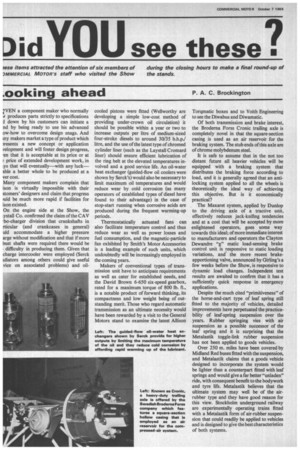DidYOU see these?
Page 48

If you've noticed an error in this article please click here to report it so we can fix it.
rese items attracted the attention of six members of during the closing hours to make a final round-up of
MMERC1AL MOTOR'S staff who visited the Show the stands.
. 00king ahead P. A. C. Brockington ▪ VEN a component maker who normally d produces parts strictly to specifications J. down by his customers can initiate a nd by being ready to use his advanced ow-how to overcome design snags. And my makers market a type of product which resents a new concept or application velopment and will foster design progress, 'en that it is acceptable at its price or at : price of extended development work, in Lys that will eventually—with any luck— able a better whole to be produced at a ver cost.
Many component makers complain that ison is virtually impossible with their stontere designers and claim that progress uld be much more rapid if facilities for ison existed.
On the engine side at the Show, the .ystall Co. confirmed the claim of the CAV .bo-charger division that crankshafts in rticular (and crankcases in general) aid accommodate a higher pressure arge without modification and that if more bust shafts were required there would be difficulty in producing them. Given that charge intercooler, were employed (Serck tdiators among others could give useful vice on associated problems) and oil cooled pistons were fitted (Wellworthy are developing a simple low-cost method of providing under-crown oil circulation) it should be possible within a year or two to increase outputs per litre of medium-sized four-stroke diesels to around 30/35 b.h.p./ litre, and the use of the latest type of chromed cylinder liner (such as the Laystall Cromard finer) should ensure efficient lubrication of the ring belt at the elevated temperatures involved and a good service life. An oil-water heat exchanger (guided-flow oil coolers were shown by Serck's) would also be necessary to limit maximum oil temperatures and would reduce wear by cold corrosion (as many operators of established types of diesel have found to their advantage) in the case of stop-start running when corrosive acids are produced during the frequent warming-up periods.
Thermostatically actuated fans can also facilitate temperature control and thus reduce wear as well as power losses and fuel consumption, and the magnetic-particle fan exhibited by Smith's Motor Accessories is a leading example of such units, which undoubtedly will be increasingly employed in the coming years.
Makers of conventional types of transmission unit have to anticipate requirements as well as cater for established needs, and the David Brown 6-650 six-speed gearbox, rated for a maximum torque of 800 lb. ft., is a notable product of forward thinking, its compactness and low weight being of outstanding merit. Those who regard automatic transmission as an ultimate necessity would have been rewarded by a visit to the General Motors stand to examine the latest Allison Torqmatic boxes and to Voith Engineering to see the Diwabus and Diwamatic.
Of both transmission and brake interest, the Brodema Forss Cronic trailing axle is completely novel in that the square-section casing is used as an air reservoir for the braking system. The stub ends of this axle are of chrome molybdenum steel.
It is safe to assume that in the not too distant future all heavier vehicles will be equipped with a braking system that distributes the braking force according to load, and it is generally agreed that an antilocking system applied to all the wheels is theoretically the ideal way of achieving this objective. But is it economically practical?
The Maxaret system, applied by Dunlop to the driving axle of a tractive unit, effectively reduces jack-knifing tendencies and at a cost that will be accepted by more enlightened operators, goes some way towards this ideal; of more immediate interest to manufacturers and operators the Clayton Dewandre "g" matic load-sensing brake control unit is responsive to static loading variations, and the more recent brakeapportioning valve, announced. by Girling 's a few weeks before the Show, is responsive to dynamic load changes. Independent test results are awaited to confirm that it has a sufficiently quick response in emergency applications.
Despite the much cited "primitiveness" of the horse-and-cart type of leaf spring still fitted to the majority of vehicles, detailed improvements have perpetuated the practicability of leaf-spring suspension over the years. Rubber springing vies with air suspension as a possible successor of the leaf spring and it is surprising that the Metalastik toggle-link rubber suspension has not been applied to goods vehicles.
Over 250 m. miles have been covered by Midland Red buses fitted with the suspension, and Metalastik claims that a goods vehicle designed to incorporate the system would be lighter than a counterpart fitted with leaf springs and would give a far better "unladen" ride, with consequent benefit to the bodywork and tyre life. Metalastik believes that the ultimate system may well be of the airrubber type and they have good reason for this view. Stockholm underground railway are experimentally operating trains fitted with a Metalastik form of air-rubber suspension that could readily be applied to vehicles and is designed to give the best characteristics of both systems.




















































































































